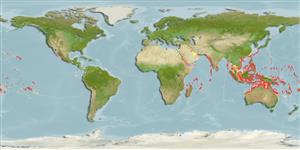Environment: milieu / climate zone / depth range / distribution range
Ecology
Marine; reef-associated; depth range 3 - 50 m (Ref. 90102). Tropical; 30°N - 30°S
Indo-Pacific: known from the Red Sea and Christmas Island in the Indian Ocean; ranging to the Tuamoto Islands, north to southern Japan, south to New Caledonia and Rapa. Western Indian Ocean: Mozambique (Ref. 41878).
Size / Weight / Age
Maturity: Lm ? range ? - ? cm
Max length : 10.0 cm TL male/unsexed; (Ref. 2334); common length : 7.0 cm SL male/unsexed; (Ref. 37816)
Dorsal spines (total): 8; Dorsal soft rays (total): 9; Anal spines: 2; Anal soft rays: 8. Characterized by having dorsal fin rays VII-I, 9; anal fin rays II,8; pectoral fin rays 14; pelvic fin rays I, 5; pored lateral line scales 24; predorsal scales 4; circumpeduncular scales 12; total gill rakers 24, developed gill rakers 18; snout pointed; body white in color (Ref. 93839). Further characterized by alternating black and yellow stripes, dark stripes wider; greatest depth of body 2.6-3.1 in SL (Ref. 90102).
Occurs on reef flats and shallow lagoon reef, usually seen singly or in pairs under ledges or in crevices. Feed on small benthic invertebrates at night (Ref. 2141).
Life cycle and mating behavior
Maturity | Reproduction | Spawning | Eggs | Fecundity | Larvae
Mouthbrooders (Ref. 240). Distinct pairing during courtship and spawning (Ref. 205).
Randall, J.E. and E.A. Lachner, 1986. The status of the Indo-West Pacific cardinalfishes Apogon aroubiensis and A. nigrofasciatus. Proc. Biol. Soc. Wash. 99(1):110-120. (Ref. 2141)
IUCN Red List Status (Ref. 130435: Version 2024-2)
Threat to humans
Harmless
Human uses
Tools
Special reports
Download XML
Internet sources
Estimates based on models
Preferred temperature (Ref.
123201): 25.4 - 28.9, mean 27.7 °C (based on 594 cells).
Phylogenetic diversity index (Ref.
82804): PD
50 = 0.5000 [Uniqueness, from 0.5 = low to 2.0 = high].
Bayesian length-weight: a=0.00794 (0.00407 - 0.01549), b=3.34 (3.17 - 3.51), in cm total length, based on LWR estimates for this species & (Sub)family-body (Ref.
93245).
Trophic level (Ref.
69278): 3.6 ±0.4 se; based on diet studies.
Resilience (Ref.
120179): High, minimum population doubling time less than 15 months (Preliminary K or Fecundity.).
Fishing Vulnerability (Ref.
59153): Low vulnerability (10 of 100).
Nutrients (Ref.
124155): Calcium = 163 [86, 282] mg/100g; Iron = 0.969 [0.554, 1.636] mg/100g; Protein = 18.5 [17.4, 19.6] %; Omega3 = 0.112 [0.062, 0.207] g/100g; Selenium = 37 [17, 80] μg/100g; VitaminA = 83.8 [26.8, 256.6] μg/100g; Zinc = 2.02 [1.31, 2.97] mg/100g (wet weight);
